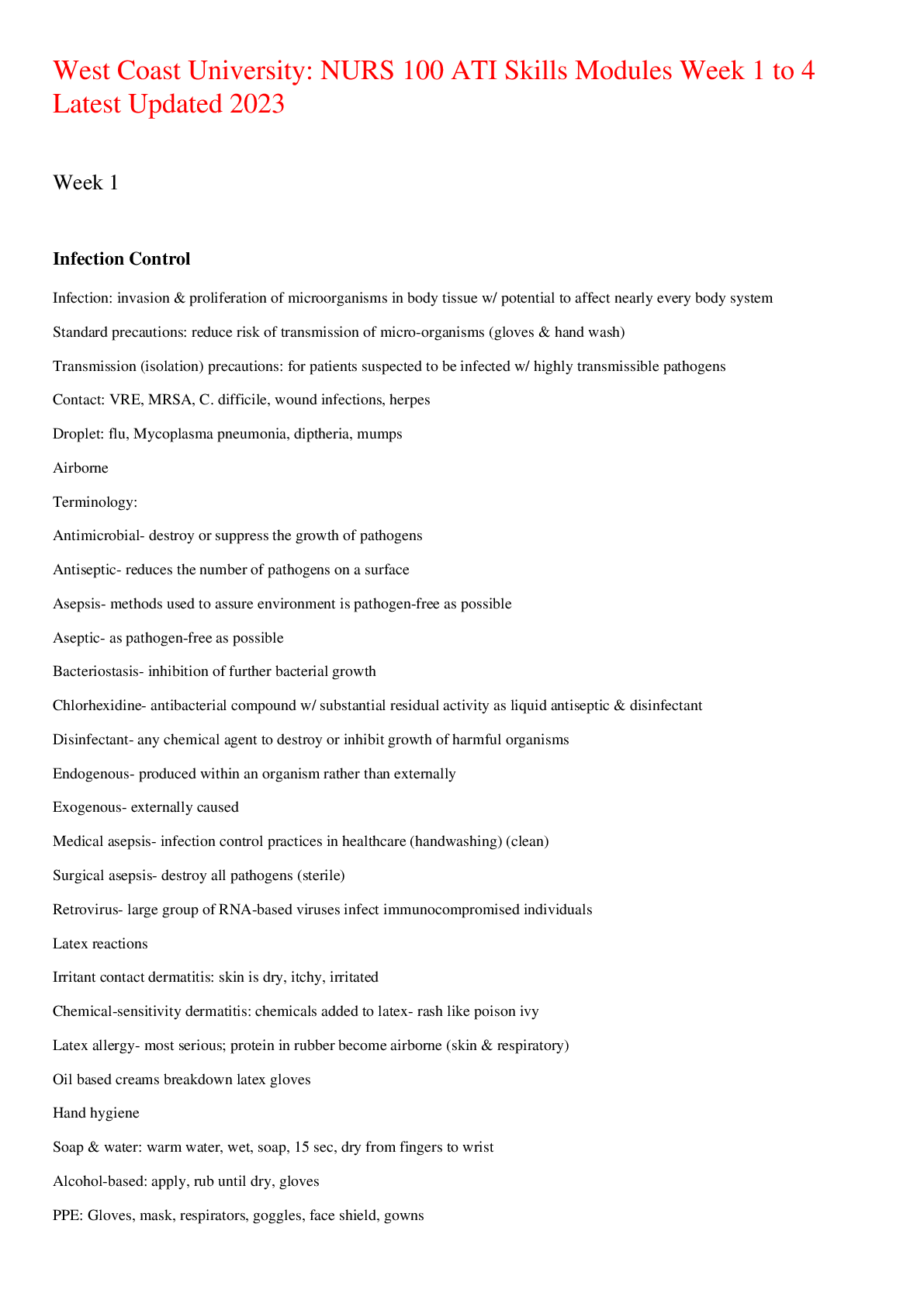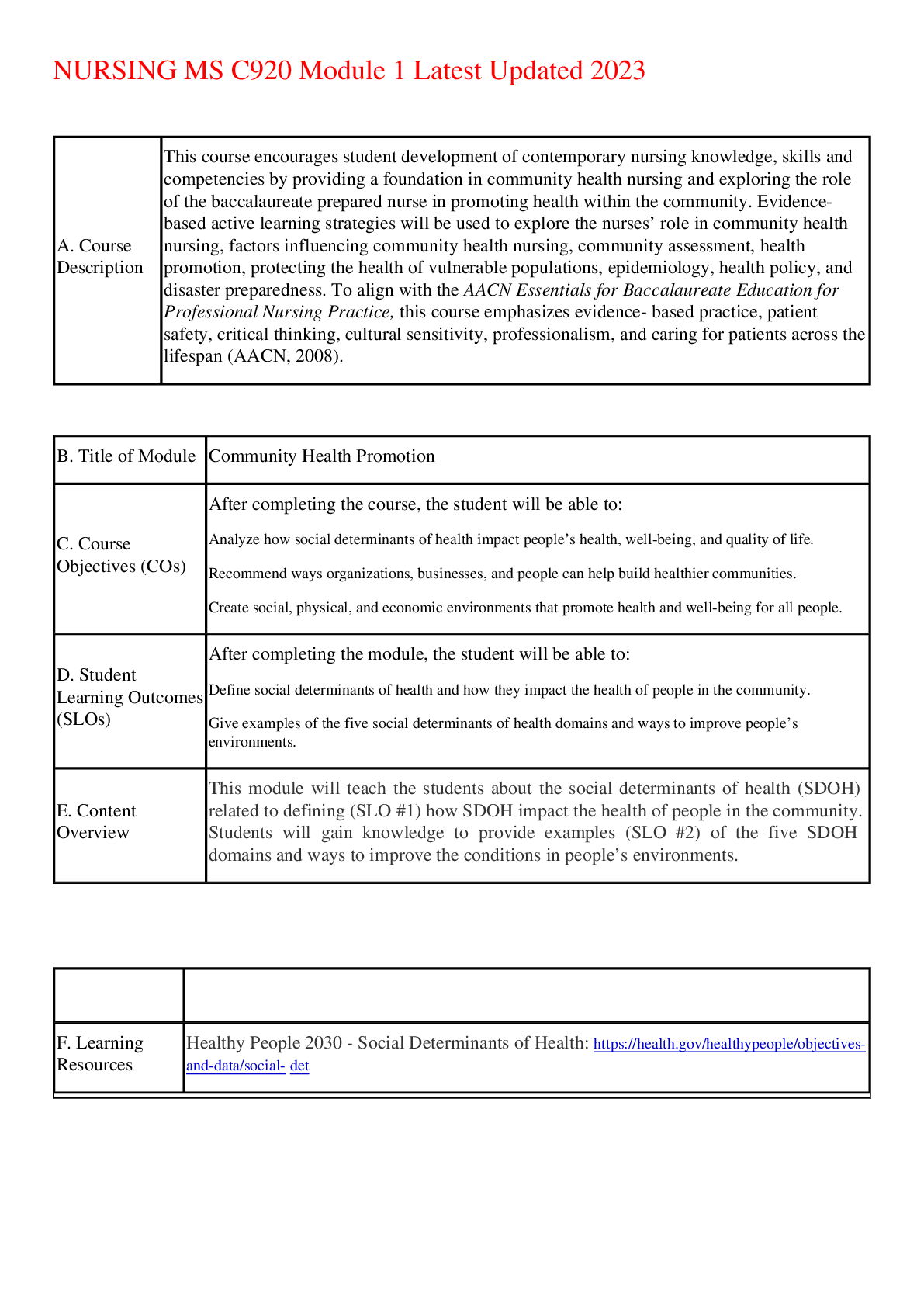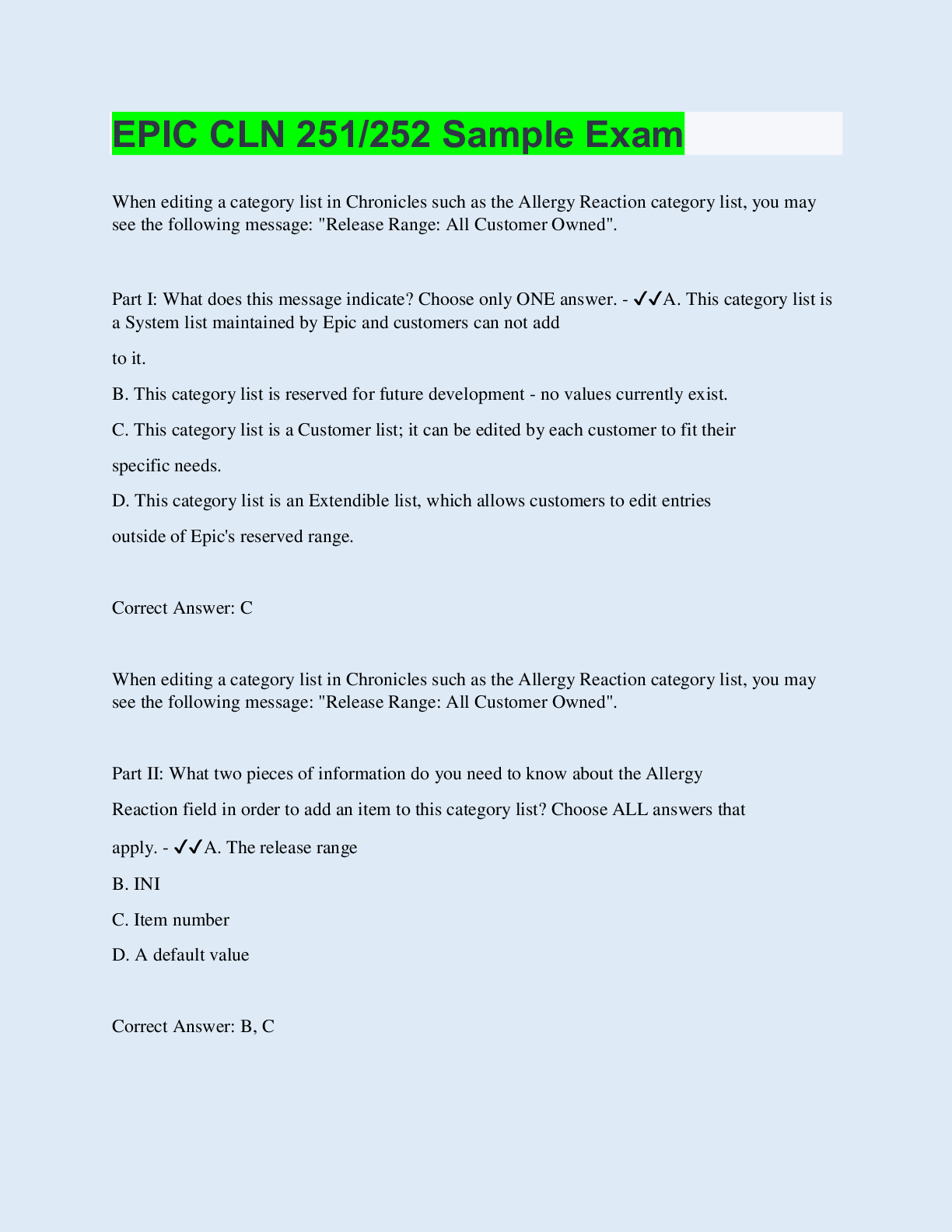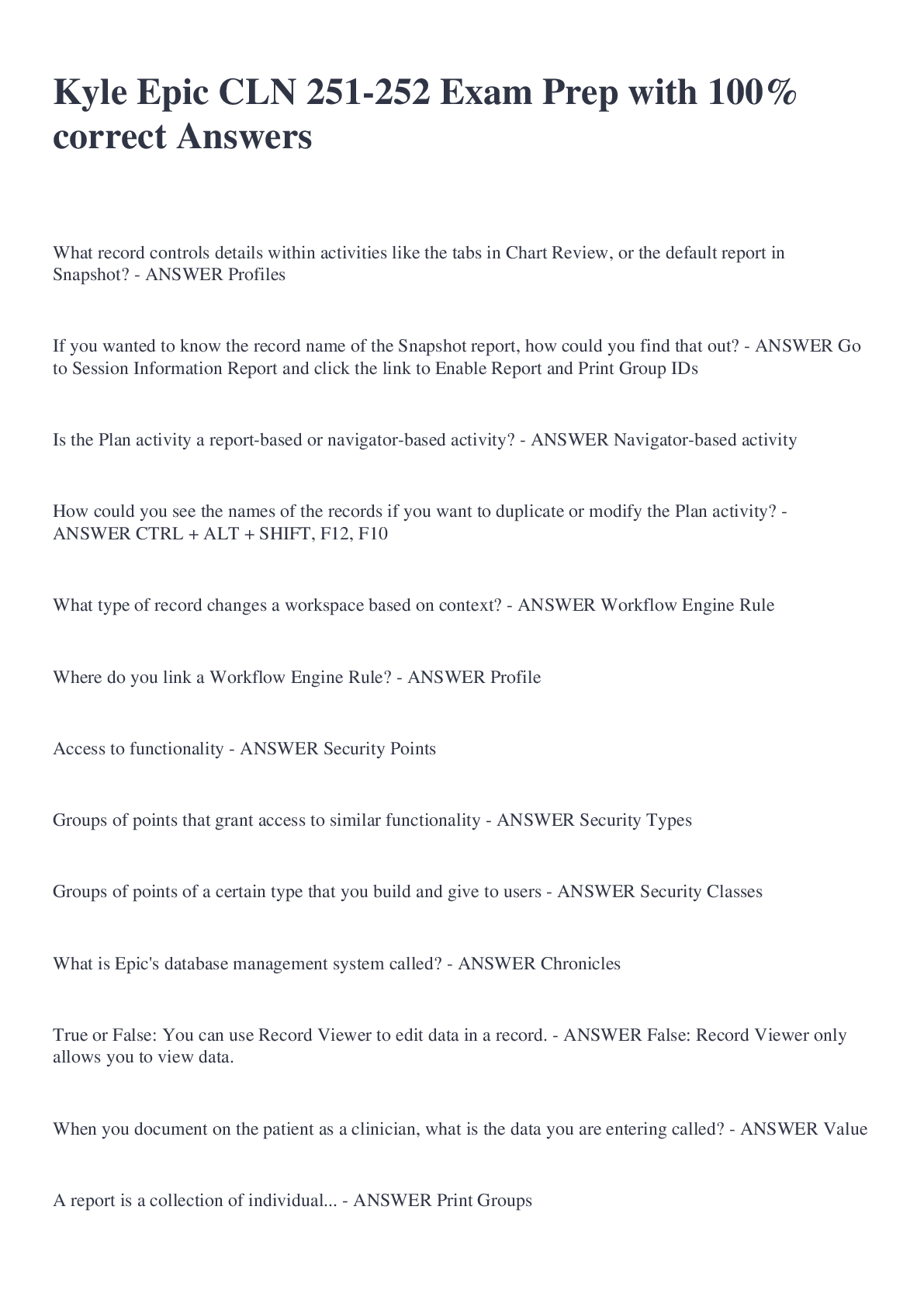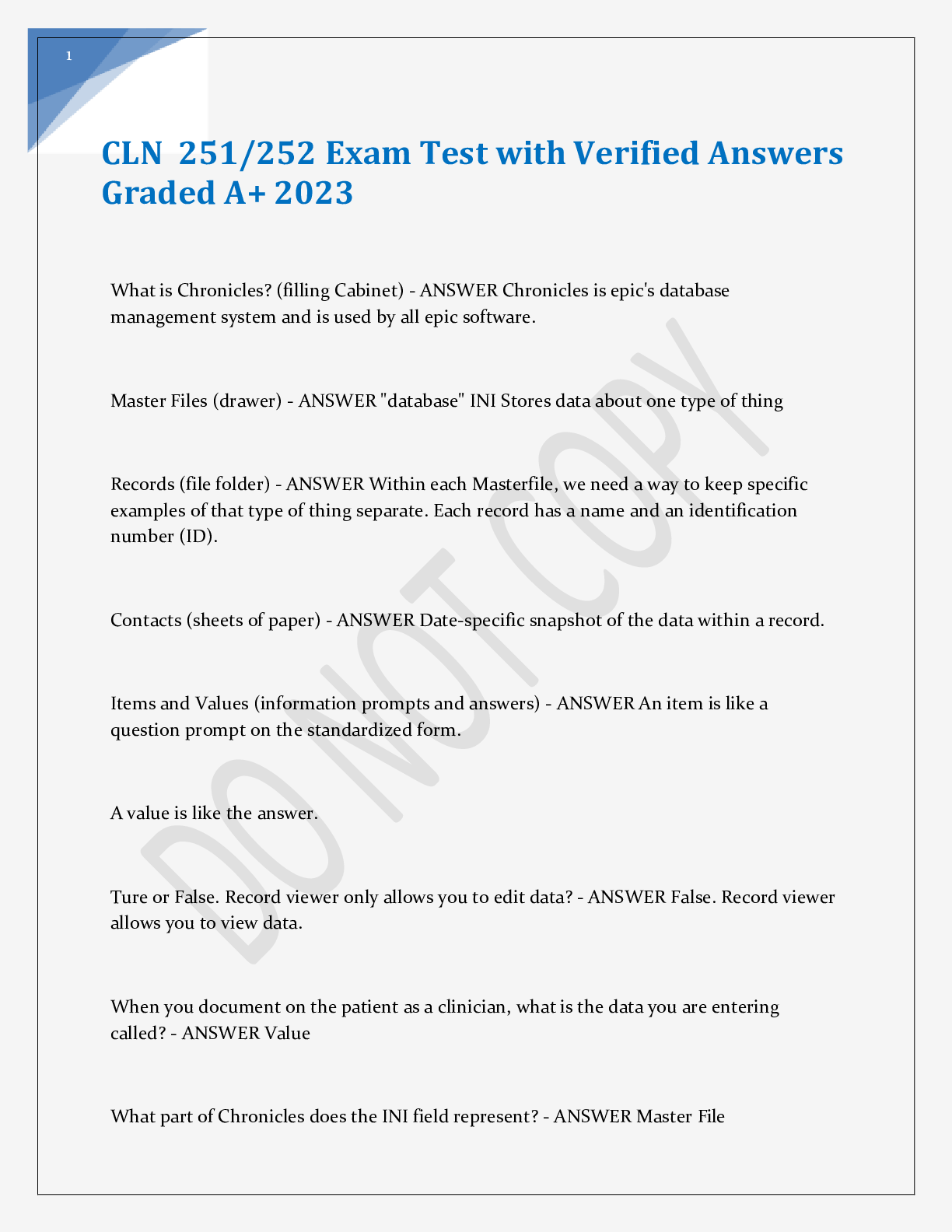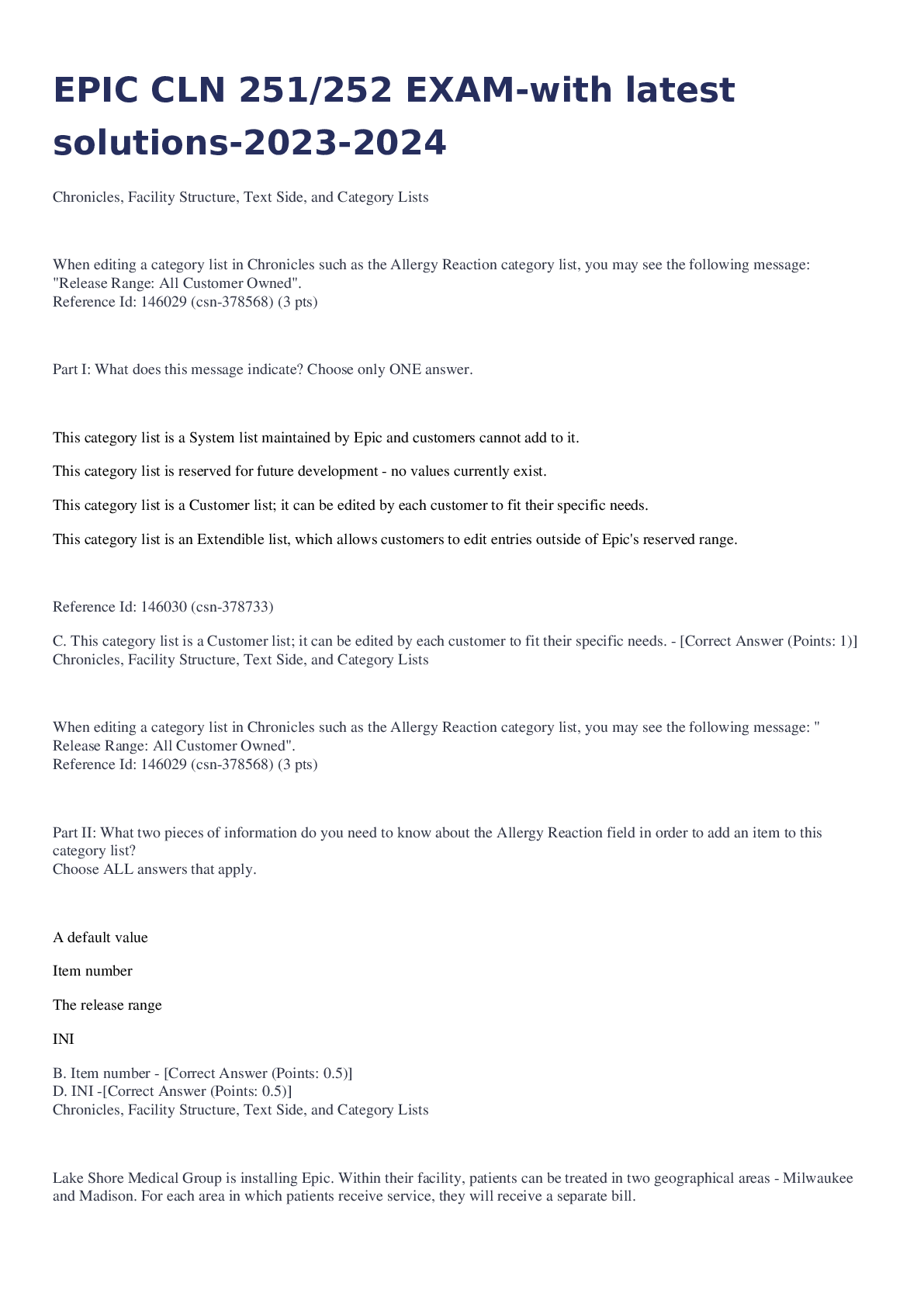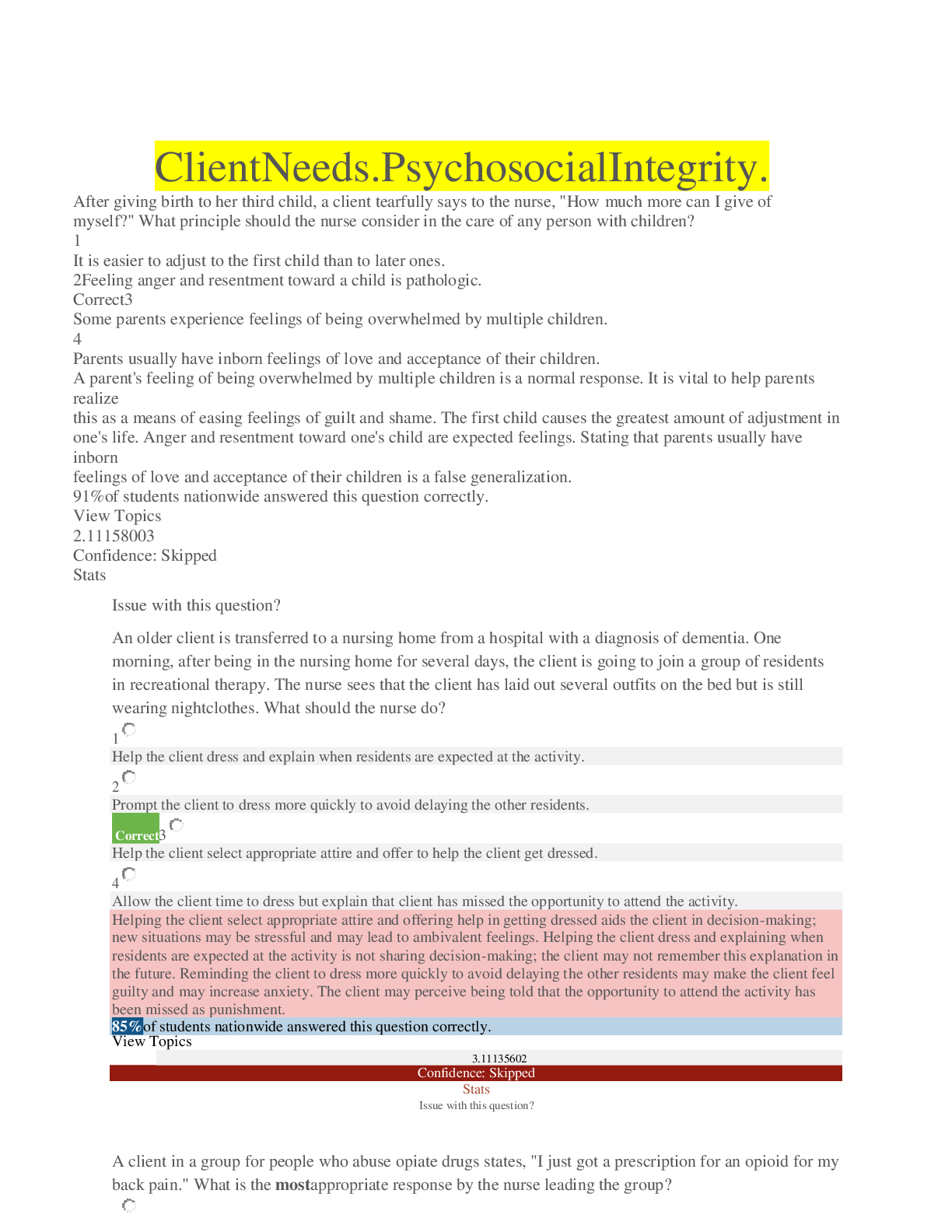NURSING MS C920 Module 1 Latest Updated 2023,100% CORRECT
Document Content and Description Below
NURSING MS C920 Module 1 Latest Updated 2023 A. Course Description This course encourages student development of contemporary nursing knowledge, skills and competencies by providing a foundation in... community health nursing and exploring the role of the baccalaureate prepared nurse in promoting health within the community. Evidence-based active learning strategies will be used to explore the nurses’ role in community health nursing, factors influencing community health nursing, community assessment, health promotion, protecting the health of vulnerable populations, epidemiology, health policy, and disaster preparedness. To align with the AACN Essentials for Baccalaureate Education for Professional Nursing Practice, this course emphasizes evidence- based practice, patient safety, critical thinking, cultural sensitivity, professionalism, and caring for patients across the lifespan (AACN, 2008). B. Title of Module Community Health Promotion C. Course Objectives (COs) After completing the course, the student will be able to: 1. Analyze how social determinants of health impact people’s health, well-being, and quality of life. 2. Recommend ways organizations, businesses, and people can help build healthier communities. 3. Create social, physical, and economic environments that promote health and well-being for all people. D. Student Learning Outcomes (SLOs) After completing the module, the student will be able to: 1. Define social determinants of health and how they impact the health of people in the community. 2. Give examples of the five social determinants of health domains and ways to improve people’s environments. E. Content Overview This module will teach the students about the social determinants of health (SDOH) related to defining (SLO #1) how SDOH impact the health of people in the community. Students will gain knowledge to provide examples (SLO #2) of the five SDOH domains and ways to improve the conditions in people’s environments. F. Learning Resources Healthy People 2030 - Social Determinants of Health: https://health.gov/healthypeople/objectives-and-data/social- determinants-health G. Scenario-Based Learning Activity Healthy People 2030 focuses on creating social, physical, and economic environments that promote health and well-being for all people. For this activity, students will work in small groups. Students will use their course materials and additional learning resource to answer the discussion questions related to the case study. Case Study: Lisa is a 32-year-old single, Hispanic mother with two children. Lisa and her children live with her elderly parents, in an old apartment on the fourth floor in an urban city. Lisa is the primary care giver for both her parents and children. Lisa works as a waitress and is on her feet for at least eight hours every shift. Lisa has a high school diploma but has had no luck in finding a less strenuous and better paying job. As a part-time waitress, she brings home enough money to pay rent, utilities, car payment, car insurance, and some basic needs, such as food. Lisa is responsible for the family’s grocery shopping. Her mom likes traditional Hispanic foods. Lisa tries her best but often gets food from the food pantry and other organizations in the community. Lisa’s daughters are seven and nine years old. The nine-year-old has mild asthma and uses an Albuterol inhaler as needed. Lisa does not have health insurance, so when she or her children are sick, they go to the ER for care. Recently, she has had frequent visits with her daughter and uncontrolled asthma attacks. Lisa has her daughters go to an after-school program. She does not like her daughters walking home in her neighborhood as the crime incidence rate has increased substantially since Lisa was a little girl. Discussion Questions: 1. Identify and explain five social determinants of health issues from the case study. 2. Why is it important for nurses to understand the social determinants of health? 3. What recommendations would you offer to help Lisa’s current financial and social issues? 4. What current and future health and quality of life issues may occur as a result of Lisa’s current status? 5. As a community health nurse, what can you do to help Lisa and her family? Module 2 A. Course Overview This course encourages student development of contemporary nursing knowledge, skills and competencies by providing a foundation in community health nursing and exploring the role of the baccalaureate prepared nurse in promoting health within the community. Evidence-based active learning strategies will be used to explore the nurses’ role in community health nursing, factors influencing community health nursing, community assessment, health promotion, protecting the health of vulnerable populations, epidemiology, health policy, and disaster preparedness. To align with the AACN Essentials for Baccalaureate Education for Professional Nursing Practice, this course emphasizes evidence- based practice, patient safety, critical thinking, cultural sensitivity, professionalism, and caring for patients across the lifespan (AACN, 2008). B. Title of Module Improving the Health of Vulnerable Populations C. Course Objectives (COs) After completing the course, the student will be able to: 1. Analyze correlations between healthy behaviors and increased quality of life for vulnerable populations. 2. Create a community program to improve the health of a vulnerable population group in the community. 3. Assess opportunities and challenges for creating a community program that serves a vulnerable population group. D. Student Learning Outcomes (SLOs) After completing the module, the student will be able to: 1. Identify vulnerable populations in the community. 2. Discuss how community programs improve the health of vulnerable population groups. E. Content Overview This module will teach the students about vulnerable populations related to identifying (SLO #1) vulnerable populations in the community. Students will gain knowledge to discuss (SLO #2) how creating community programs help vulnerable population groups improve their overall health, well-being, and quality of life. F. Learning Resources To supplement course material, students will read a research article on how community sport programs improve the health of vulnerable population groups. This article will give students an example of how to develop a community program to meet the needs of vulnerable populations in the community. Van der Veken, K., Lauwerier, E., & Willems, S. J. (2020). How community sport programs may improve the health of vulnerable population groups: a program theory. International Journal for Equity in Health, 19(1), 1– 12. https://doi.org/10.1186/s12939-020-01177-5 G. Scenario-Based Learning Activity Providing programs and services to help vulnerable populations in the community can help people engage in healthy behaviors and increase their quality of life. For this activity, students will work in small groups. Students will: -Identify vulnerable populations in the community. -Create a community program to help a vulnerable population group. -Design a brochure to explain your program’s purpose and services. -Present your community program and brochure to the class. Use a standard 8 ½” x 11” bifold or trifold design. Ideas for your brochure: Explain your program’s purpose and services Answer frequently asked questions Offer how-to or health info Tell how to find out more about your program Promote an event Include pictures Module 3 A. Course Overview This course encourages student development of contemporary nursing knowledge, skills and competencies by providing a foundation in community health nursing and exploring the role of the baccalaureate prepared nurse in promoting health within the community. Evidence-based active learning strategies will be used to explore the nurses’ role in community health nursing, factors influencing community health nursing, community assessment, health promotion, protecting the health of vulnerable populations, epidemiology, health policy, and disaster preparedness. To align with the AACN Essentials for Baccalaureate Education for Professional Nursing Practice, this course emphasizes evidence- based practice, patient safety, critical thinking, cultural sensitivity, professionalism, and caring for patients across the lifespan (AACN, 2008). B. Title of Module Epidemiology C. Course Objectives (COs) After completing the course, the student will be able to: 1. Evaluate the quality and comparability of epidemiological data to determine prioritization needs. 2. Assess health trends to identify risk factors specific to groups withing the community. 3. Recommend community programs based on identified teaching and learning needs within the community. D. Student Learning Outcomes (SLOs) After completing the module, the student will be able to: 1. Describe epidemiology and the role of the public health nurse. 2. Identify three risk factors that affect the spread of disease. E. Content Overview This module will teach the students to recognize the importance of epidemiological concepts related to describing (SLO #1) epidemiology as a foundation of community health nursing and the role of the public health nurse. Students will gain knowledge to identify (SLO #2) known or potential risk factors that effect the spread of disease in a community. F. Learning Resources To supplement course material, an interactive learning activity on The Centers for Disease Control and Prevention (CDC) website allows students to analyze data and information to “Solve the Outbreak.” https://www.cdc.gov/mobile/applications/sto/web-app.html G. Scenario-Based Learning Activity This module will implement the flipped classroom method. Students will listen to the narrated PowerPoint presentation and complete weekly readings prior to class and be ready to participate in activities that will enhance understanding of important concepts. Students will be broken up in to small groups of 3-4 students. Students will read a case study regarding an outbreak in the community and answer questions to unfold the clues and figure out the source of the outbreak. You are working as a community health nurse in a large metropolitan city in the Midwest. Within the past two days, 15 people have visited emergency rooms complaining of high fever, fatigue, coughing, chest pain, and difficulty breathing. Several of these people have died, and others are near death. The first reported case is a 37-year-old musician from Chicago named Eli. You start by talking to Eli to find out what he was doing before he got sick. What are some of the questions you would ask Eli? Eli said that he started coughing and feeling very tired shortly after he led a music workshop for fifty students at a local concert hall. He thought he might have picked something up from one of the students in the class or caught it two days ago on the flight home from vacation. What additional information do you want to know about Eli? You learn that Eli and several friends took a trip to West Africa last week. While they were there, Eli took a side trip to meet a drum maker who taught him to make a drum using animal skins and wood. Eli brought home four of the drums he made. Eli and his friends all came home together on the same flight. What additional actions might you do next? After interviewing Eli’s friends, you learn that he is the only one who has gotten sick since returning home. Where do you think Eli caught whatever made him sick? It’s still too soon to tell when or how he caught his sickness. We don’t even know what disease we are dealing with yet. You need to find out what Eli has before you can determine what made him sick. More cases of the mysterious illness are being reported in hospitals all over Chicago. Lab results show patients are infected with a bacterium that doctors think is anthrax. You immediately send the samples to the CDC for testing, but that will take a couple of days. In the meantime, as the public health nurse, you need to talk to everyone who is sick and their families to find out where and what they were doing before getting sick. Is there any additional information you would like to know? Anthrax is a serious disease caused by a type of bacteria. It is not contagious. Anthrax is naturally found in soil and can infect domestic and wild animals. Animals get sick when they eat anthrax spores in contaminated soil or vegetation. You continue your investigation. Information is gathered directly from sick patients and families. You also interview 85 people who are not sick, but participated in similar activities of those who are sick or died. These people are considered the “at risk” population. This information is used to determine an attack rate. The attack rate takes the number of people who participated in an activity and are sick divided by the total number of people who participated in an activity. Compute the attack rates based on the interviews with the people who got sick and those who did not get sick. To find a possible source of an outbreak, a public health nurse will look for both a high attack rate for those who participated in an activity and a low attack rate among those who did not participate. Based on the information you collected and the attack rates you calculated, where do you suspect people got infected with anthrax? What is your next step in the investigation? Next steps to consider are to recheck the data to see if there is one activity or exposure that all sick people have in common, interview workers in every government building, or cancel all music events. It looks like all of the sick people attended a music event in Chicago. But what about the high number of sick people who work in a government building? With the large number of government workers who are sick, you decide to investigate more. Police reports show that there was a bioterrorism threat three days before Eli and the others got sick. Postal workers are watching for suspicious packages but nothing has been found. There are sick people up to 90 miles away. These sick people told you they had not been in or near the government buildings in Chicago. Other clues seem to be pointing to something else but what could it be? After questioning, testing at government buildings, and lab tests, authorities find no further evidence. The bioterror threat was a hoax. In the meantime, the results from the CDC show the bacterium is anthrax. The doctors now diagnose each patient with inhalation anthrax and begin treatment immediately. What should you do now? You review the attack rates and interviews again. Findings show that everyone who has tested positive for anthrax also attended a music event at the same concert hall where Eli held his music workshop. What do you think started the outbreak? It is very likely that the release of anthrax occurred at the music event. Maybe something or someone at the music event had been contaminated. Would this explain how Eli got sick? All the people who became sick in this outbreak were together on the day of the music workshop. You’re pretty sure that the workshop is where anthrax was released, but you are still not sure how. What should the public health nurse recommend for the 35 healthy workshop participants? The healthy workshop participants should be given antibiotics to prevent sickness, called post-exposure prophylaxis. How do you figure out how the anthrax infected people? To determine how the anthrax was released, you talk to Eli again. You find out that Eli demonstrated how to make a drum using goat skins he brought back from West Africa in his music workshop. Follow-up interviews with workshop participants were conducted. After asking specific questions about the drum presentation, people remember seeing a lot of dust and particles floating in the air. How do you think the anthrax got into the music workshop? Spores were released from the drums and skins that Eli used in the music workshop. People were infected during the music workshop, as well as the concert in the same music hall. [Show More]
Last updated: 1 year ago
Preview 1 out of 10 pages
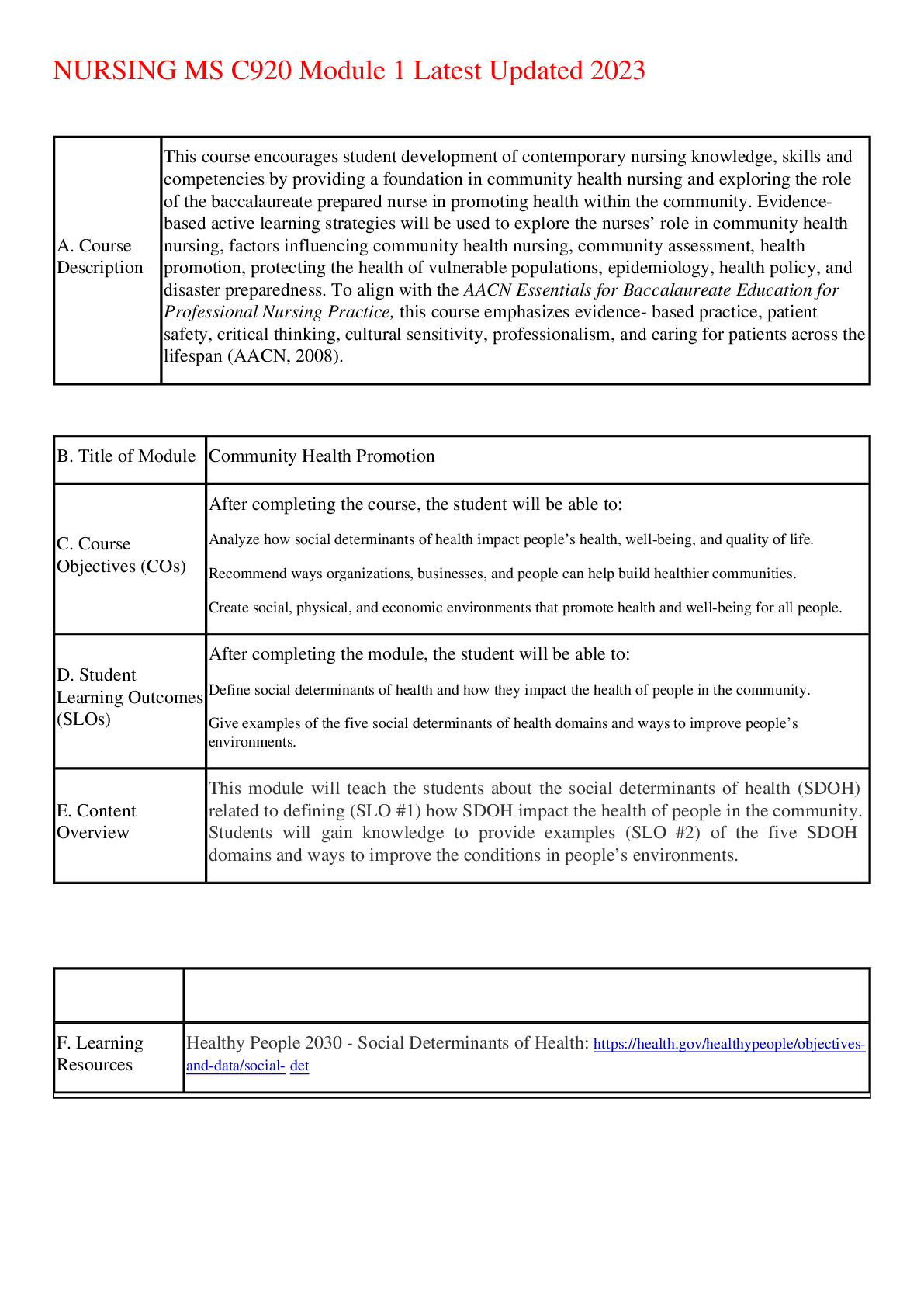
Reviews( 0 )
Document information
Connected school, study & course
About the document
Uploaded On
Mar 12, 2023
Number of pages
10
Written in
Additional information
This document has been written for:
Uploaded
Mar 12, 2023
Downloads
0
Views
30

















